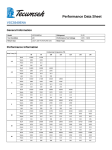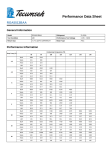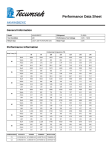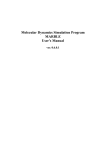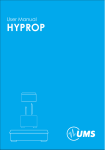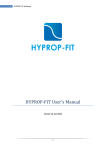Download SHYPFIT User's Manual
Transcript
SHYPFIT User’s Manual Wolfgang Durner Draft Version 0.24, November 10, 1998 Durner W., SHYPFIT 0.24 User’s Manual. Research Report 95.1, Department of Hydrology, University of Bayreuth, D-95440 Bayreuth, Germany, 25pp, 1995. Contents 1 Overview 1.1 Retention Functions . . . . . . . . . . . . . . . . . . . . . . . . . 1.2 Parameter Optimization . . . . . . . . . . . . . . . . . . . . . . . 1.3 Conductivity Estimation . . . . . . . . . . . . . . . . . . . . . . 1 1 2 3 2 Running the Program 2.1 Program Elements . . . . 2.2 Program Input . . . . . . 2.2.1 Interactive Runs 2.2.2 Batch Runs . . . 2.3 3 . . . . . . . . . . . . . . . . . . . . . . . . . . . . . . . . . . . . . . . . . . . . . . . . . . . . . . . . . . . . . . . . . . . . . . . . . . . . . . . . 5 5 5 5 6 2.2.3 Inputfile datafile . . . 2.2.4 Inputfile SHYP.INI . . Program Output . . . . . . . . 2.3.1 Screen Output . . . . . 2.3.2 Outputfile SHYP.ERG 2.3.3 Outputfile SHYP.TAB . . . . . . . . . . . . . . . . . . . . . . . . . . . . . . . . . . . . . . . . . . . . . . . . . . . . . . . . . . . . . . . . . . . . . . . . . . . . . . . . . . . . . . . . . . . . . . . . . . . . . . . . . . . . . . . . . . 6 8 13 13 13 14 . . . . . . 15 15 15 15 15 16 16 . . . . . . . . Miscellaneous 3.1 Optimizing WGS . . . . . . . . . . . . . . . . . . . . . 3.2 Choice of Modality . . . . . . . . . . . . . . . . . . . . 3.3 Plotting Retention Curves from Given Parameter Values . 3.4 Confidence Limits . . . . . . . . . . . . . . . . . . . . . 3.5 Truncating Pore Sizes . . . . . . . . . . . . . . . . . . . 3.6 Technical Notes . . . . . . . . . . . . . . . . . . . . . . . . . . . . . . . . . . . . . . . . . . . . . . A Example Inputfile SHYP.DAT 20 B Example Inputfile SHYP.INI 20 C Hardcopy of screen for data example 21 D Example Outputfile SHYP.ERG 22 E Example Outputfile SHYP.TAB 23 ii Disclaimer The program SHYPFIT is a non-commercial product for scientific use. The program can be used and copied for other users without restriction. According to my knowledge, the program is free of severe bugs. However, the actual program version 0.2 has not been thoroughly tested so far. There is no warranty for it of any kind, whether expressed or implied. The SHYPFIT user is responsible for ascertaining the suitablility of the program for any use and consequently has all the responsibility and cost that may arise from using it. It is not recommended to forward a copy of this version to new users. Rather, interested scientists should directly write to me, so that they can get the latest program version. SHYPFIT is available via anonymous ftp from server btgyx2.geo.unibayreuth.de, on directory pub/msdos/shypfit. Users who fetch the software may want to send an information to me by e-mail. By this, they can be put on the mailing list for notification of bug-fixes and updates. Bayreuth, November 10, 1998. Dr. W. Durner Dept. of Hydrology University of Bayreuth D-95440 Bayreuth Germany iii Wolfgang Durner Phone+49-921-552147 Fax +49-921-552263 email [email protected] Fast Start Follow the instructions below, if you hate reading User Manuals, but want to see immediately whether, and how, SHYPFIT works on your PC: 1. Insert the SHYPFIT disk into the disk drive (assumed A). 2. From the hard disk, run the archive extraction program by typing A:SHYPINST by typing its name and pressing the RET key. This will expand some files on a subdirectory SHYPFIT. 3. Verify that the ANSI.SYS driver is installed on your system (if you are unsure, see chapter 3.6). Change to the subdirectory SHYPFIT and run the program executable SHYPFIT.EXE by typing its name and pressing the RET key. 4. Communicate with the running program interactively by typing the answers to the questions, followed by RET . If you are not sure about an answer, choose the default value by just pressing the RET key. 5. If you want to run SHYPFIT with your own data, prepare an ASCII datafile “<name>”.DAT with your measured retention data in a format according to the example file SHYP.DAT. The file must contain a title in line 1, the single character “1” in line 2, and datapairs for the measured matric pressures and the related water content data in the following lines (for more details, see chapter 2.2.3). iv 1 OVERVIEW 1 1 Overview SHYPFIT (Soil Hydraulic Properties Fitting) is a computer program designed to fit uni- and multimodal retention functions to measured water retention data, and to compute the related relative hydraulic conductivity function. To run the program, a data file with the measured water retention data is required as input. Some control commands and parametes for model choice, initial parameter values, bounds for parameter values, output control etc. have to be entered interactively or are read from a parameter file. If required, the user can tailor the parameter-optimization procedure to his specific needs. SHYPFIT’s output consists of a protocol file, a results file, and optionally of a file which containes the optimized hydraulic functions in tabular form. During an optimization run, the current fitting progress is shown in real-time graphics. When fitting retention functions to measured data, two important criteria are: (i) the correct model choice, and (ii) the precise estimation of the model parameters. The best (and simplest) method to judge on the reliability of the optimization result is to view a plot showing the measured data and the fitted retention curve, and to view a plot of the deviations between them. Slovenly expressed, if the curve is fitted to the data in a way as the user would do it by hand, the result is satisfying. If the model choice was correct, the deviations should be uncorrelated, i.e. look more or less randomly scattered. The aim when fitting retention functions to data is generally not the “precise” determination of a fifth digit of any function parameter, but a good description of measured data. 1.1 Retention Functions In SHYPFIT, one of the following functions can be selected for the description of the retention characteristic: The model of Brooks and Corey (1964), 8 , < for =: a 1 for a the unimodal model of van Genuchten (1980), !m = 1 + (1 j j)n a ; >1 1 ; (1) (2) or the model of Durner (1993), which is a multimodal form of van Genuchten’s equation, #mi " X 1 = wi 1 + ( j j)ni : (3) i i=1 1 OVERVIEW 2 Equations (1), (2), and (3), calculate the effective saturation as a function of the matric potential [L, if expressed in pressure head units] in the unsaturated range ( < 0). The effective saturation is defined by = ,,r : s r (4) where [–] is the volumetric water content, s [–] is the saturated water content and r [–] is the residual water content. In (1), a [L] is the matric potential at the air entry point, and [–] is a parameter related to the width of the pore-size distribution. Typical values for range from 0.25 for sands to 0.1 for clays. In (2), [L,1 ] is a scaling parameter for the matric potential, and n [–] and m [–] are curve–shape coefficients. Equation (3) is a linear superposition of van Genuchten curves. Its parameter [–] indicates the modality of the pore-size distribution. P Each subcurve is defined by its weight wi [–], subject to 0 < wi < 1 and 1 wi = 1, and the curve shape parameters ai > 0 [L,1], ni > 1 [–], and mi > 0 [–], which can be interpreted analogous to the original van Genuchten parameters. The properties of these models and the related pore-size distributions are discussed by Durner (1991, 1992, 1993) and, specifically for Eq. (2), by Nielsen and Luckner (1992). 1.2 Parameter Optimization The model parameters of the retention functions are optimized by minimizing the objective function nd 2 X Z (P ) = wi ^( i; P ) , i (5) i=1 where Z (P ) is the objective variable, P is the parameter vector, i is the measured water content at matric potential i , ^( i; P ) is the estimated value of at i , nd is the number of – data pairs, and wi are weighing factors, which are set equal in the present implementation of the program. Note that the optimization procedure does not minimize the euclidic distance in the – plane. The nonlinear optimization routine of SHYPFIT follows a modified “golden search” algorithm (Press et al., 1992). This algorithm is robust and strictly converging. A disadvantage lies in its slow convergence close to the minimum, particularly if parameters are correlated. Generally, the search will converge towards the global minimum of the objective function, if the number of simultaneously optimized parameters is low. However, if 2–modal or 3–modal curves are fitted, the objective function may possess local minima, which sometimes cause problems. To overcome this difficulty, the initial parameter estimates can be manipulated, and the parameter space can be bound. 1 OVERVIEW 3 The optimization process stops when at least one of the following criteria is met: (i) the parameters estimates are sufficiently precise, i.e., the bracketing intervalls for all optimized parameters are below their limiting values; (ii) the total fitting error is smaller than some prescribed value; (iii) the fitting error does no longer improve from iteration to iteration. The typical number of iterations required to meet one of these criteria is around 10-20 for 2-parameter fittings, and becomes larger if more parameters are to be fitted, since then the correlation between parameters becomes more important. The CPU time requirements for a three-parameter optimization are typically in the range of seconds (486 CPU), but increase with each additional parameter by a factor of 3. Further, the time increases linearly with the number of matricpotential data. 1.3 Conductivity Estimation Hydraulic properties of porous media can be estimated from pore-size distributions considering microscopic conceptual models for pore connectivity and pore tortuosity. Since pore-size distributions can be deduced from water-retention curves, statistical models have been developed, where the relative hydraulic conductivity function is estimated from the water-retention curve. The theory of conductivity estimation models has been extensively reviewed by Mualem (1986, 1992). For a discussion of the assumptions, the problems, and the reliability of conductivity estimations, the SHYPFIT user is referred to this original literature. Durner (1993) has discussed the conductivity estimation problem with specific respect to soils with heterogeneouos pore-size distributions. In general, the relative hydraulic conductivity function, Kr () [–], is estimated from the water retention curve. The relative conductivity, Kr , is defined by Kr = K=Ks , where K and Ks are the absolute and the saturated conductivity [LT,1 ], respectively. To calculate absolute conductivities, the relative conductivity function must be 7matched to a measured value. Often the saturated conductivity is used for matching. Due to estimation uncertainties near saturation this is however not recommended for structured soils. In SHYPFIT, one of the following predictive models can be chosen: the model of Burdine (1953) Z 1 . Z s 1 2 0 0 Kr = d 2 d 0 2 0 the model of Mualem (1976) "Z Kr = 0 1 d0. Z s 1 d0 0 #2 ; (6) ; (7) 1 OVERVIEW 4 or the model of Alexander and Skaggs (1988) Z . Z s 1 Kr = 1 d0 d0 0 0 : (8) The parameter [–] in (7) is an empirical tortuosity factor, generally set to 0:5. = In SHYPFIT, the relative conductivities are computed by numerical evaluation of Kr = "Z 0 a , d .Z 1 0 0 a , d0 # : (9) Equations (6), (7), and (8) become special cases of Eq. (9), dependent on the values of the parameters , , and . The accuracy of the numerical approximation was verified for the unimodal cases by comparison with analytical solutions. The relative conductivity function can be matched to any measured conductivity by K () = KK(r() ) Kref (10) r ref where the Kref indicates the measured conductivity at water content ref . 2 RUNNING THE PROGRAM 2 5 Running the Program 2.1 Program Elements The following diagram shows the input and output files which are involved in an optimization run. The files in square brackets are optional. 8 > < SHYP.CTR datafile ,! SHYPFIT ,! >: SHYP.ERG [SHYP.INI] [SHYP.TAB] All input and output files are of ASCII format. They are specified as follows: datafile contains measured retention data. SHYP.INI controls the run specifications. If a file SHYP.INI is located on the current directory, SHYPFIT tries to read the run specifications from it. If a file of that name does not exist, SHYPFIT requires interactive program input. SHYP.ERG is a file on which the results of optimization runs are written. If the file exists already, new data are appended. Otherwise, the file is newly created. SHYP.CTR is a file that containes a protocol of the run specifications. Its format is identical to SHYP.INI. Therefore it can be used after a first run as input file for further runs. The content of SHYP.CTR is overwritten at each run. SHYP.TAB is a datafile which is optionally created by SHYPFIT and containes the hydraulic functions in tabular form. If SHYP.TAB exists already, SHYPFIT appends the hydraulicproperties table to the existing file. Each table is written with a four-line header which allows to identify the contents of the table. The tables can be used for plotting the hydraulic relationsships or for numerical simulation programs. 2.2 Program Input 2.2.1 Interactive Runs SHYPFIT inquires at the beginning of each run the name “datafile” of the file with the measured retention data. If a file SHYP.INI exists, all other run specifications will be read from it, otherwise, a minimum number of interactive inquiries will follow, asking for the model type, the modality, and some other basic parameters. 2 RUNNING THE PROGRAM 6 If the optimization does not match the stop criteria after NITMAX iterations, the following menu will appear on the screen (here for NITMAX = 40): +---------------------------------------------------------+ | Stop criteria after 40 Iterations not met ! | | | | Should the program | | >(0) go on | | (1) stop | | (2) restart with new initial parameter estimates | | (NN) continue with NN (>2) additional interations ? | +---------------------------------------------------------+ Pressing RET will activate the default action “0”, i.e., the program assumes the fit to be sufficiently accurate and proceeds with the hydraulic conductivity estimation. Entering “1” will stop the run without further computations, entering “2” will ask for new initial values of the model parameters. Entering a number nn greater or equal to “3” will increase the parameter NITMAX by nn, and the optimization continues until either the stop criteria are met or the same menu appears again on the screen. 2.2.2 Batch Runs SHYPFIT can process consecutively a series of different data files. In such cases, an ASCII file named FILELIST.DAT must be created, which containes just the data filenames (without extension), one name on each line. SHYPFIT automatically searches for the existence of such a datafile on the current directory. Contrary to the normal mode, SHYPFIT will not inquire interactively on how to proceed if the convergence criteria are not met within the prescribed maximum number of iterations. It is therefore recommended to set the value of NITMAX in the file SHYP.INI (see below) to a reasonable high value (e.g. 40). If the plot option is set on (KPLOT 6= 0), the fitted curves will be shown on the monitor and pressing RET is required to proceed to the next datafile. If the plot option is set off, no inquiry will occur during the run. 2.2.3 Inputfile datafile The measured retention data must be written on a file with the name extension “.DAT”. Table 1 shows the required format of the data file. 2 RUNNING THE PROGRAM 7 Table 1: Format of inputfile datafile. column 1 line 2 j nPAR 1 2 3 . . . title NCOL h(1) . . . WC(1,1) . . . [WC(1,2) . . . . .. . .. .. . WC(1,j) . . . . .. . .. .. . WC(1,nPAR)] . . . i . . . nh h(i) . . . WC(i,1) . . . [WC(i,2) . . . . .. . .. .. . WC(i,j) . . . . .. . .. .. . WC(i,nPAR)] . . . (nh) WC(nh,1) [WC(nh,2) WC(nh,j) WC(nh,nPAR)] The variables in Tab. 1 are specified as follows: title Title line which helps to identify the data. The lines must contain less that 50 characters; its text appears on the plot and in the output files. NCOL Column number j for water content data to be used in the optimization. Data from the j -th column are used in the fitting procedure. Note: if NCOL = 1, the data will be filtered, very similar data will be lumped thereby reducing the total number of data. To avoid the filtering, set NCOL = –1. NCOL = ,j : the arithmetic mean of all water contents of column 1 to column j will be used in the fitting procedure. h(i) Matric potentials i (hPa or kPa) or, equivalently, matric pressure heads (in cm water column, m water column, or pF1 ). The unit of the matric potential is inquired interactively, or read from the file SHYP.INI. If no unit is specified, is assumed to be in pF or cm water column (automatic recognition). WC(i,j) Volumetric water contents which are related to h(i). SHYPFIT recognizes the units by considering the magnitude of the values: The water contents are considered absolut if 0 < max 1, or in % if 1 < max < 100, where max is the largest measured water content. nh Number of different matric potential values (1 nh 1500). nPAR Number of water content data at each matric potential (1 nPAR 12). By using this data format, this number has to be equal for each matric potential. All entries in Tab. 1 are free of format, i.e., they can be written in integer or real format, and the columns have not to be aligned at specific positions. The values 1 The pF is a logarithmic unit for the matric potential. It is defined by pF is the matric pressure head in cm water column. log10 (, ) where 2 RUNNING THE PROGRAM 8 in square brackets are optional. 2.2.4 Inputfile SHYP.INI If a file SHYP.INI is used to specify the program parameters, it is recommendable to create by an interactive dummy run the protocol file SHYP.CTR. This file then can be edited with a text editor and modified according to the needs. Finally this file can be renamed and used as input file for subsequent runs. The format of SHYP.INI is given by Table 2, the entries are explained in Table 3: Table 2: Format of inputfile SHYP.INI. Line 1 2 3 4 5 6 7 8 9 10 . . . Content “datafile” MODEL MODE NITMAX KAPPA BETA TAU KSPR RMAX IUNIT KPLOT PL PR WL WR 0 1 12 1 2 .50 0 .1E+35 0 1 0 5 .0 .5 ...INI ND ...MIN ...MAX D...INI d... MIN ...Name .00000 0 .000000 1.0000 .0100 .0001 WGS .00025 1 .000000 .4000 .0200 .0001 WGR .00500 1 .000001 10.0000 2.0000 1.0010 A1 1.60000 1 1.000000 50.0000 2.0000 1.0010 N1 .37500 0 .000000 100.0000 2.0000 1.0010 M1 1.00000 0 .010000 .9900 .1000 .0100 WEIGHT1 . . . . . . . . . . . . . . . . . . . . . Table 3: Variables of inputfile SHYP.INI. Line Variable : 1 : : : : Dummy line : The line is not interpreted by the program. 2 : : : : Dummy line Content If SHYP.INI was created by SHYPFIT, the line containes the name of the related datafile. The line is not interpreted by the program. If SHYP.INI was created by SHYPFIT, this line containes the names of the program parameters. The names are explained in the context of line 3. 3 : : : : Values of the : program parameters: 2 RUNNING THE PROGRAM MODEL ::::: MODE :::::: NITMAX 9 Type of basic retention function 0: Equation (3), m = 1 , 1=n; 1: Equation (3), m = 1; 2: Equation (3), m = optimized; 3: Equation (1). Modality of the retention function. Possible values depend on the model choice, as follows: 1: Unimodal (any retention model); 2: Bimodal (only for TYPE = 0, 1, or 2); 3: Trimodal (only for TYPE = 0 or 1). : : : : Maximum number of iterations. If the stop criteria are not reached after NITMAX iterations, the programm inquires interactively how to proceed (see next section). KAPPA ::::: Coefficient of the conductivity prediction model, Eq. (9). BETA :::::: Coefficient of the conductivity prediction model, Eq. (9). TAU : : : : : : : : Tortuosity coefficient of the conductivity prediction model, Eq. (9). KSPR :::::: Index for writing the hydraulic functions in tabular form on a file SHYP.TAB (see section 2.3.3). 0: Don’t write on SHYP.TAB, 1: Write hydraulic functions on SHYP.TAB. RMAX: : : : : : : : Pore radius, rmax [mm], which limits the maximum pore size considered in the hydraulic conductivity prediction model. See section 3 (“Truncating Pore Sizes”) for details. IUNIT ::::: Index for the matric–potential units in the datafile: 0: pF 1: hPa 2: kPa 3: cm water column 4: m water column 2 RUNNING THE PROGRAM KPLOT ::::: PL ::::::::: PU ::::::::: WL ::::::::: WU ::::::::: 4 : : : : Dummy line Index for getting during the fitting process a real time graphics on the PC monitor. retention function and predicted conductivity function are plotted versus the matric potential. The axis ranges are determined by the parameters PL, PU, WL, and WU. Note: This option is only valid on PC’s. -1: Linear axis for matric potential. 0: No plot. 1: pF axis for matric potential. Scaling parameter for plot of the retention function: matric potential at origin of the abscissa. Scaling parameter for plot of the retention function: matric potential at end of the abscissa. Scaling parameter for plot of the retention function: water content at origin of the ordinate. Scaling parameter for plot of the retention function: water content at end of the ordinate. : If SHYP.INI was created by SHYPFIT, line 4 containes the names of the variables in lines 5ff . The names are explained in the context of line 5. 5 : : : : Initial values, bounds, and variation parameters for the saturated water content s , as follows: WGS INI : : : Initial value of parameter WGS. If this value is set to zero, the highest water content in the current dataset is taken as WGS. ND WGS :::: Index controlling optimization of parameter WGS: 0: parameter is kept constant at initial value, 1: parameter is optimized. WGS MIN : : : Lower bound for parameter WGS. WGS MAX : : : Upper bound for parameter WGS. DWGS INI : : Initial value of absolute variation width DWGS (see comments below). DWGS MIN : : Minimum absolute variation width DWGS (see comments below). varname: : : : : Name of parameter. This entry is not interpreted by SHYPFIT and may contain any information or be empty. 10 2 RUNNING THE PROGRAM 11 6 : : : : WGR: : : : : : : : : Initial values, bounds, and absolute variation parameters for the residual water content, r . 7 : : : : A1: : : : : : : : : : : Initial values, bounds, and relative variation parameters for 1 (if TYPE 6= 3) or 1= a (if TYPE = 3). 8 : : : : N1: : : : : : : : : : : Initial values, bounds, and relative variation parameters for n1 , if TYPE 6= 3. Dummy line else. 9 : : : : M1: : : : : : : : : : : Dummy line, if TYPE = 0 or 1. Initial values, bounds, and relative variation parameters for n1 (if TYPE = 2) or for of the Brooks and Corey model, Eq. (1) (if TYPE = 3). 10 :: WEIGHT1: : : : Initial values, bounds, and absolute variation parameters for w1. If MODE=1, this is a dummy line since then, by definition, w1 = 1. 11-14 : : : : : : : : : : : : : Initial values, bounds, and variation parameters for 2 , n2 , m2, and w2 of the multimodal retention model, Eq. (3) (cf. lines 7 to 10). These entries are not read if MODE = 1. 15-18 : : : : : : : : : : : : : Initial values, bounds, and variation parameters for 3 , n3 , m3, and w3 of the multimodal retention model, Eq. (3) (cf. lines 7 to 10). These entries are not read if MODE 2. In the following, some additional remarks with regard to the contents of Table 2 are given. The bracketing interval for a parameter P extends from P INI + DP to P INI , DP if the variation is absolute (i.e. for WGS, WGR, and the weights), whereas it extends from (P INI , P MIN)=DP to (P INI , P MIN) DP if the variation is relative (i.e. for , n, and m). The initial variation width is determined by the entries tt DP INI in SHYP.INI. If the objective function has its minimum at the center of the bracketing interval, the size of DP will be diminished for the next iteration. Otherwise, it will be enlarged. With continuing iterations, DP converges towards zero for absolute variations, and towards 1 for relative variations. If DP is smaller than DP MIN, then it is assumed that the parameter P is determined with sufficient precision. The default values the variables in SHYPFIT depend on model type and modality. For the standard case of fitting a unimodal van Genuchten equation are they listed in Tab. 2. 2 RUNNING THE PROGRAM 12 The type of prediction model is determined by the specific combination of the parameters KAPPA, BETA and TAU. The entries in SHYP.INI may be incomplete. This is true with respect to the entries in one line or equivalently with respect to the number of lines required by the particular model choice. In such cases, SHYPFIT uses its internal default values for the missing values and prints out a warning message. All entries in SHYP.INI are free of format; hence it is not necessary to write the parameter values at certain column positions. However, note that the entries of each parameter line may have no missing value ahead of a specified parameter value (e.g., if you want explicitly to set parameter bounds, you must specify also the initial values and the variation index ND). Inconsistent entries are to some extent detected and automatically corrected. Examples are: (i) For the unimodal model (MODE=1) the parameter w1 is set to 1.0, regardles of the entries in line 10; more general, the weight wi with i = MODE is always determined by the previous weights wi with i P MODE--1 and the constraint wi = 1:0. (ii) If, in a bimodal optimization, one of the two weights, w1 or w2, is allowed to vary, the other one varies too, regardless of its specific ND value. (iii) If the initial value of a parameter is larger than the specified maximum value or smaller than its minimum value, SHYPFIT corrects it automatically. It is generally recommended to use the default values of SHYP.CTR. See section 3.1 for additional hints regarding the treatment of the parameter s . 2 RUNNING THE PROGRAM 13 2.3 Program Output 2.3.1 Screen Output If SHYPFIT is successful in activating the VGA graphics mode, the measured data and the fitted retention function are plotted at each iteration as a real–time graphics on the screen, thus allowing to monitor the fitting progress (See Fig. A1 in appedix A). At the upper left of the screen, the values of the retention- function parameters are shown. They are updated at each iteration. Those parametes which are allowed to vary are labelled by the sign “,”.The value of the parameter is given in a unit which is inverse to the unit specified in SHYP.INI for the matric-potential measurements. The last two lines in the parameter list indicate the current number of iterations (NIT), and the root mean square fitting error, q P RMSE = 1=n (i , ^i )2 , where i , ^i is the difference between fitted and measured water content at the i-th matric potential. The axes of the plot of the water retention curve are scaled automatically according to the range of values of the measured data. Alternatively, they can be prescribed in SHYP.INI. After the optimization has finished, the information on RMSE and NIT can be erased from the screen by entering RET . Pressing RET a second time will plot the estimated relative hydraulic conductivity function, Kr ( ) on the same graphics window. The ordinate for Kr is logarithmic, and labelled on the right hand side of the plot. Pressing RET a third time will finish the run and return to DOS. 2.3.2 Outputfile SHYP.ERG The file SHYP.ERG containes the optimized parameters and a table of measured and fitted water contents and the residuals. The file is self–explaining. If a file with that name exists on the current directory, the output will be appended to the existing content. SHYP.ERG will include a warning message, if the predicted relative hydraulic conductivity function has dropped at a matric- potential of 1 hPa by more than one order of magnitude (see the discussion of parameter RMAX in section 3.5). 2 RUNNING THE PROGRAM 2.3.3 14 Outputfile SHYP.TAB The file SHYP.TAB (Tab. 3) containes tables of the soil hydraulic relationships and some control information on the related model parameters. The file is of the form Table 4: Format of outputfile SHYP.TAB Line 1 2 3 4 5 6 . . . 104 105 106 Content title TYPE 0 pF -3.0 -2.9 . . . MODAL IUN WGR WGS A1 N1 W1 A2 N2 W2 2 0 .005 .50 .3922 2.51 .31 .00022 1.34 .69 WG(pF) Krel(pF) Cap(pF) p(Se) Se .499999 .89852E+00 .113721E-02 .100000E+36 .000 .499999 .89149E+00 .122303E-02 .292477E+08 .010 . . . . . . . . . . . . . . . 6.9 .005413 .46070E-16 .230861E-08 .810502E+00 .990 7.0 .005000 .23869E-16 .169483E-08 .000000E+00 1.000 -------------------------------------------------------------- The first line containes a copy of the title line of datafile. The second and third lines contain the names and values of the model parameters, respectively, as described in section 2.2.4. The fourth line is the column header for the table below, which reaches from line 5 to line 105. The bottom line 106 containes minus signs, indicating the end of the table. The six columns in lines 4 to 105 contain two independent tables. The first four columns list pF , (pF ), Kr (pF ), and C (pF ) = d=d in the pressure range from pF 0 (= ,100 cm pressure head) to pF 7 (= ,107 cm pressure head). The two columns p(Satur.) and Saturation list the inverted function () in the saturation range from = 0 to = 1. Note: If the Brooks and Corey retention model has been chosen, columns five ans six are not printed, since the inversion can be easily done analytically. 3 MISCELLANEOUS 3 15 Miscellaneous 3.1 Optimizing WGS If the saturated and the residual water content are optimized simultaneously, the convergence of the fitting algorithm can become quite slow, requiring in cases hundreds of iterations to find the minimum. Therefore it is recommendable to set the saturated water content to the greatest measured value (this is achieved automatically if WCS INI = 0). If laboratory data are used, this will generally lead to good results. However, if data from field measurements are used which scatter considerably near saturation, s should also be optimized. 3.2 Choice of Modality It is generally a good idea to describe a dataset as simply as possible. The unimodal constrained or unconstrained van Genuchten model will in many cases be appropriate. If a more flexible description is required, the bimodal retention curve with mi = 1 , 1=ni (TYPE = 0, default) and with flexible weights of the subcurves is in most cases a very good choice. In exceptional cases, e.g., if there is an equally high pore density over a considerable range of pore sizes, application of the threemodal model can be necessary. Since the required CPU time increases by a factor of three for each additional free parameter, it is recommended to keep in such cases the three weights constant at values which can be a priory roughly estimated by viewing the data. Further, the residual water content can be set very often to zero without loss of fitting accuracy. 3.3 Plotting Retention Curves from Given Parameter Values SHYPFIT can be used as a convenient tool for creating tables or plots of retention curves and conductivity curves, if function parameters are given. To achieve this, set all ND’s to zero, and run SHYPFIT. A dummy file datafile, which containes just one pair of synthetic data, can be used to scale the axes of the retention curve plot. Otherwise, the axis boundaries should be set by SHYP.INI, as described in section 2.2.4. 3.4 A Note on Confidence Limits According to our experience, the interpretation of confidence regions for fitting parameters can very easily lead to misconclusions: small confidence limits do not automatically mean that the chosen model describes the data in an optimal manner. Any interpretation of confidence regions depends on the assumption that the 3 MISCELLANEOUS 16 a priory chosen model type is correct, i.e., that the measured data are a random sample from a statistically homogeneous dataset with a mean retention curve that can be precisely described by the chosen model type. This is an assumption which is not easy to verify, and it is likely that a natural soil just does not posess “its” or n in the sense of a unique property. In practice, small confidence regions mean that the model parameters are estimated for a given data set with high precision because they are not correlated. Hence, small confidence limits can result even in cases where the model is obviously wrong (as an example see Fig. 2 in Durner, 1992). On the other hand, for a multimodal retention curve the parameters are often highly correlated, even if it describes measured data very well. Since retention-curve parametes are not further interpreted in an isolated manner (which is in contrast to parameters of solute transport models), SHYPFIT does not print any confidence limits. 3.5 RMAX – Truncating Pore Sizes Truncating the pore sizes to some maximum value can be of importance for wide pore-size distributions, as indicated by a value of the van Genuchten parameter n close to unity. In such cases, the asymptotic shype of the retention model close to saturation represents a very small, but (for hydraulic conductivity prediction purposes) not negligible part of the pore space in the range of very large pores. This can cause an unrelistic decrease in the hydraulic conductivity prediction near saturation, such that at a matric potential of, say – 1 hPa, Kr has already dropped by orders of magnitude. Since SHYPFIT evaluates the integral in Eq. (9) numerically, it is possible to restrict the largest pore sizes considered in the conductivity prediction to a reasonable value. By this, all pore space covered by pores with equivalent radii larger than the specified size is treated as if the pores had the allowed maximum size. Generally it appears reasonable to set this maximum pore size RMAX in the range 1 to 5 mm, since for larger pores the Darcy law (and hence the definition of K ), is probably no longer valid. Soils with macropores should be treated by different approaches. By default, the pore sizes for the prediction are not truncated, i.e., RMAX = 1. Note that for retention curves with large n the truncation has no effect. For a more extensive discussion of the topic see Durner (1991, p. 108–118). 3.6 Technical Notes PC Settings The program SHYPFIT uses ANSI escape sequences to control the screen output. For a correct interpretation of these sequences it is necessary that the ANSI device driver is loaded. This is done by including the command REFERENCES 17 DEVICE = C:\DOS\ANSI.SYS in the file CONFIG.SYS. The path description in the above command must be directed towards the directory that contains the file ANSI.SYS. Monitor A VGA monitor with appropriate graphics card is necessary to monitor the fitting progress in real-time on the screen. Hardcopy of Graphics The graphics on the monitor screen can be printed (in a low resolution) by pressing the “Printscreen” key, if previously the DOS command GRAPHICS [device] has been called. See the DOS manual for more information. Data Size Limits The maximum number of matric potential data is 1500, the maximum number of water retention measurements at one matric potential is 12. Chosing Default Values In the interactive menues, the default values are indicated by the “>” symbol. Pressing the RET key activates these defaults. The default value for the name of the file with the measured retention data is “SHYP.DAT”. References [1] Brooks R.H., and A.T. Corey, 1964: Hydraulic properties of porous media. Hydrology Paper 3, Colorado State University, Fort Collins, CO, 1–27. [2] Burdine N.T., 1953: Relative permeability calculations from pore size distribution data. Petroleum Transactions, American Institute of Mining and Metallurgical Engineers 198, 71–87. [3] Durner W., 1991: Vorhersage der hydraulischen Leitf¨ahigkeit strukturierter B¨oden. Bayreuther Bodenkundliche Berichte 20, 1–180. Fakult¨at f¨ur Biologie, Chemie und Geowissenschaften der Universit¨at Bayreuth, Postfach 101251, D - 95447 Bayreuth, Germany. [4] Durner W., 1992: Predicting the unsaturated hydraulic conductivity using multi-porosity water retention curves, in Proceedings of the International Workshop, Indirect Methods for Estimating the Hydraulic Properties of Unsaturated Soils, edited by M.Th. van Genuchten, F.J. Leij, and L.J. Lund, University of California, Riverside, 185–202. REFERENCES 18 [5] Durner W., 1993: Hydraulic conductivity estimation for soils with heterogeneous pore structure. Water Resources Research, in press. [6] Mualem Y., 1976: A new model for prediction of the hydraulic conductivity of unsaturated porous media. Water Resources Research 12, 513–522. [7] Mualem Y., 1986: Hydraulic conductivity of unsaturated soils: prediction and formulas, in Methods of Soil Analysis, Part 1: Physical and Mineralogical Methods, 2nd Ed., edited by A. Klute, pp 799–824, ASA and SSSA, Madison, Wisconsin. [8] Mualem Y., 1992: Modeling the hydraulic conductivity of unsaturated porous media, in Proceedings of the International Workshop, Indirect Methods for Estimating the Hydraulic Properties of Unsaturated Soils, edited by M.Th. van Genuchten, F.J. Leij, and L.J. Lund, University of California, Riverside, 15–36. [9] Nielsen D.R. and L Luckner, 1992: Theoretical aspects to estimate reasonable initial parameters and range limits in identification procedures for soil hydraulic properties, in Proceedings of the International Workshop, Indirect Methods for Estimating the Hydraulic Properties of Unsaturated Soils, edited by M.Th. van Genuchten, F.J. Leij, and L.J. Lund, University of California, Riverside, 147–160. [10] Press W.H., S.A. Teukolky, W.T. Vetterling, B.P. Flannery, 1992: Numerical Recipes. The Art of Scientific Computing, 2nd edition. Cambridge University Press, 1992. [11] van Genuchten M.Th., 1980: A closed-form equation for predicting the hydraulic conducitivity of unsaturated soils. Soil Science Society of America Journal 44, 892-898. Appendix A Example Inputfile SHYP.DAT B Example Inputfile SHYP.INI C Hardcopy of screen for data example D Example Outputfile SHYP.ERG E Example Outputfile SHYP.TAB A EXAMPLE INPUTFILE SHYP.DAT 20 A Example Inputfile SHYP.DAT Bimodal Test 1 .00 .5 1.00 .464291 1.40 .387130 1.60 .336629 1.80 .290358 2.00 .253044 2.50 .193152 2.80 .166984 3.00 .148982 3.50 .102527 4.00 .067396 5.00 .034764 6.00 .024612 B ! It’s no problem to include comments ! like this to the data file. ! Just enter it following the data columns Example Inputfile SHYP.INI Bimodal Test MODEL MODE NITMAX KAPPA BETA 0 2 40 1 2 xxx_INI ND xxx_MIN .00000 0 .027073 .02461 1 .000000 .50000 1 .000001 2.00000 1 1.000000 .37500 0 .000100 .50000 1 .010000 .01000 1 .000001 2.00000 1 1.000000 .37500 0 .000100 .50000 1 .010000 TAU KSPR RMAX IUNIT KPLOT PL PR WL WR .50 1 .1E+36 0 1 0 5 .0 .6 xxx_MAX dxxx dxxx_MIN 1.0000 .0100 .000100 WCS .3995 .0200 .000100 WCR 10.0000 2.0000 1.001000 A1 100.0000 2.0000 1.001000 N1 100.0000 2.0000 1.001000 M1 .9900 .1000 .010000 WEIGHT1 10.0000 2.0000 1.001000 A2 100.0000 2.0000 1.001000 N2 100.0000 2.0000 1.001000 M2 .9900 .1000 .010000 WEIGHT2 C HARDCOPY OF SCREEN FOR DATA EXAMPLE C Hardcopy of screen for data example 21 D EXAMPLE OUTPUTFILE SHYP.ERG 22 D Example Outputfile SHYP.ERG _____________________________________________________________________ Bimodal Test Results of the 7-Parameter Optimization : --------------------------------------------------------------------Comparison of measured vs. calculated data: matric pressure -------- water contents -------[cm] measured calculated difference plot .1000E+00 .5000 .5000 .0000 | .1000E+02 .4643 .4652 -.0009 --| .2512E+02 .3871 .3871 .0000 | .3981E+02 .3366 .3361 .0005 |++ .6310E+02 .2904 .2900 .0004 |+ .1000E+03 .2530 .2533 -.0002 -| .3162E+03 .1932 .1942 -.0011 --| .6310E+03 .1670 .1672 -.0002 -| .1000E+04 .1490 .1484 .0006 |++ .3162E+04 .1025 .1021 .0004 |+ .1000E+05 .0674 .0680 -.0006 --| .1000E+06 .0348 .0350 -.0003 -| .1000E+07 .0246 .0239 .0007 |++ Retention model.............. Prediction model............. Van Genuchten m=1-1/n Mualem Sat. Water Content........... Res. Water Content........... Weight........................ alpha..[1/cm] ............... n............................ m............................ 50.0% 1.8% .6800 .04992 1.8390 .4562 fixed opt opt opt opt = 1-1/n Weight........................ alpha..[1/cm] ............... n............................ m............................ .3200 .00121 1.4638 .3169 opt opt opt = 1-1/n Number of data read.......... Average WC-Deviation......... Stop Criterion............... 13 .00044 Stagnation of fitting error E EXAMPLE OUTPUTFILE SHYP.TAB E 23 Example Outputfile SHYP.TAB bsp.DAT Bimodal Test model modal iun wgs wgr a1 0 2 0 .50 .02 .04992 pF WG(pF) Krel(pF) -3.00 .500000 .999501E+00 -2.90 .500000 .999408E+00 -2.80 .500000 .999295E+00 -2.70 .500000 .999159E+00 -2.60 .500000 .998994E+00 -2.50 .500000 .998794E+00 -2.40 .500000 .998551E+00 -2.30 .500000 .998257E+00 -2.20 .500000 .997900E+00 -2.10 .500000 .997467E+00 -2.00 .500000 .996941E+00 -1.90 .500000 .996302E+00 -1.80 .500000 .995526E+00 -1.70 .500000 .994582E+00 -1.60 .499999 .993436E+00 -1.50 .499999 .992042E+00 -1.40 .499999 .990347E+00 -1.30 .499998 .988286E+00 -1.20 .499997 .985781E+00 -1.10 .499995 .982735E+00 -1.00 .499992 .979033E+00 -.90 .499988 .974534E+00 -.80 .499982 .969067E+00 -.70 .499972 .962429E+00 -.60 .499957 .954372E+00 -.50 .499934 .944601E+00 -.40 .499898 .932761E+00 -.30 .499844 .918432E+00 -.20 .499761 .901119E+00 -.10 .499634 .880245E+00 .00 .499438 .855145E+00 .10 .499140 .825072E+00 .20 .498683 .789213E+00 .30 .497987 .746731E+00 .40 .496927 .696839E+00 .50 .495323 .638944E+00 .60 .492908 .572858E+00 .70 .489313 .499118E+00 .80 .484036 .419357E+00 .90 .476455 .336653E+00 1.00 .465884 .255572E+00 1.10 .451714 .181596E+00 1.20 .433653 .119777E+00 1.30 .411961 .730624E-01 1.40 .387543 .413374E-01 1.50 .361784 .219131E-01 n1 m1 w1 1.83 .456 .68 Cap(pF) .618206E-05 .747416E-05 .904291E-05 .109483E-04 .132633E-04 .160769E-04 .194974E-04 .236571E-04 .287167E-04 .348722E-04 .423627E-04 .514793E-04 .625767E-04 .760875E-04 .925388E-04 .112573E-03 .136973E-03 .166692E-03 .202895E-03 .246998E-03 .300728E-03 .366188E-03 .445942E-03 .543105E-03 .661471E-03 .805643E-03 .981202E-03 .119489E-02 .145480E-02 .177059E-02 .215363E-02 .261704E-02 .317540E-02 .384402E-02 .463699E-02 .556358E-02 .662161E-02 .778679E-02 .899788E-02 .101411E-01 .110442E-01 .114992E-01 .113283E-01 .104766E-01 .906827E-02 .736798E-02 a2 n2 m2 w2 .00121 1.46 .317 .32 | p(Se) Se .100000E+36 .000 .224110E+07 .010 .459080E+06 .020 .182047E+06 .030 .945899E+05 .040 .569804E+05 .050 .376821E+05 .060 .265716E+05 .070 .196338E+05 .080 .150314E+05 .090 .118316E+05 .100 .952214E+04 .110 .780336E+04 .120 .649106E+04 .130 .546715E+04 .140 .465322E+04 .150 .399564E+04 .160 .345674E+04 .170 .300950E+04 .180 .263411E+04 .190 .231582E+04 .200 .204348E+04 .210 .180853E+04 .220 .160430E+04 .230 .142560E+04 .240 .126828E+04 .250 .112907E+04 .260 .100531E+04 .270 .894888E+03 .280 .796100E+03 .290 .707573E+03 .300 .628213E+03 .310 .557141E+03 .320 .493653E+03 .330 .437164E+03 .340 .387166E+03 .350 .343179E+03 .360 .304722E+03 .370 .271288E+03 .380 .242352E+03 .390 .217379E+03 .400 .195847E+03 .410 .177269E+03 .420 .161203E+03 .430 .147264E+03 .440 .135119E+03 .450 E EXAMPLE OUTPUTFILE SHYP.TAB 1.60 1.70 1.80 1.90 2.00 2.10 2.20 2.30 2.40 2.50 2.60 2.70 2.80 2.90 3.00 3.10 3.20 3.30 3.40 3.50 3.60 3.70 3.80 3.90 4.00 4.10 4.20 4.30 4.40 4.50 4.60 4.70 4.80 4.90 5.00 5.10 5.20 5.30 5.40 5.50 5.60 5.70 5.80 5.90 6.00 6.10 6.20 6.30 6.40 6.50 6.60 6.70 .336174 .311947 .289885 .270322 .253242 .238413 .225484 .214053 .203716 .194088 .184831 .175675 .166438 .157043 .147508 .137932 .128456 .119234 .110399 .102053 .094259 .087047 .080421 .074365 .068853 .063849 .059315 .055213 .051504 .048154 .045129 .042397 .039930 .037703 .035693 .033877 .032237 .030756 .029419 .028210 .027119 .026132 .025241 .024435 .023707 .023049 .022454 .021916 .021430 .020990 .020593 .020233 .110576E-01 .541352E-02 .262212E-02 .127957E-02 .638820E-03 .329998E-03 .177482E-03 .994142E-04 .576814E-04 .343220E-04 .206823E-04 .124597E-04 .741982E-05 .433122E-05 .246610E-05 .136734E-05 .738968E-06 .390327E-06 .202221E-06 .103142E-06 .519705E-07 .259467E-07 .128666E-07 .634938E-08 .312258E-08 .153209E-08 .750562E-09 .367344E-09 .179688E-09 .878722E-10 .429689E-10 .210128E-10 .102773E-10 .502763E-11 .246007E-11 .120403E-11 .589436E-12 .288629E-12 .141366E-12 .692545E-13 .339345E-13 .166310E-13 .815216E-14 .399668E-14 .195971E-14 .961049E-15 .471362E-15 .231214E-15 .113428E-15 .556502E-16 .273056E-16 .133990E-16 24 .566475E-02 .416706E-02 .296806E-02 .207043E-02 .142939E-02 .986356E-03 .686900E-03 .487306E-03 .355037E-03 .266934E-03 .207007E-03 .164537E-03 .132647E-03 .107227E-03 .860815E-04 .681962E-04 .531597E-04 .407624E-04 .307897E-04 .229611E-04 .169464E-04 .124065E-04 .902743E-05 .653897E-05 .472092E-05 .340040E-05 .244527E-05 .175648E-05 .126080E-05 .904588E-06 .648846E-06 .465347E-06 .333732E-06 .239347E-06 .171668E-06 .123137E-06 .883349E-07 .633761E-07 .454744E-07 .326330E-07 .234204E-07 .168102E-07 .120669E-07 .866274E-08 .621943E-08 .446559E-08 .320655E-08 .230263E-08 .165362E-08 .118760E-08 .852956E-09 .612635E-09 .124486E+03 .115132E+03 .106859E+03 .995062E+02 .929379E+02 .870421E+02 .817254E+02 .769095E+02 .725290E+02 .685285E+02 .648610E+02 .614868E+02 .583718E+02 .554867E+02 .528064E+02 .503088E+02 .479752E+02 .457887E+02 .437350E+02 .418012E+02 .399759E+02 .382491E+02 .366119E+02 .350563E+02 .335751E+02 .321619E+02 .308108E+02 .295165E+02 .282743E+02 .270796E+02 .259284E+02 .248171E+02 .237420E+02 .227000E+02 .216879E+02 .207028E+02 .197419E+02 .188025E+02 .178819E+02 .169773E+02 .160861E+02 .152055E+02 .143322E+02 .134633E+02 .125948E+02 .117225E+02 .108413E+02 .994473E+01 .902428E+01 .806812E+01 .705852E+01 .596614E+01 .460 .470 .480 .490 .500 .510 .520 .530 .540 .550 .560 .570 .580 .590 .600 .610 .620 .630 .640 .650 .660 .670 .680 .690 .700 .710 .720 .730 .740 .750 .760 .770 .780 .790 .800 .810 .820 .830 .840 .850 .860 .870 .880 .890 .900 .910 .920 .930 .940 .950 .960 .970 E EXAMPLE OUTPUTFILE SHYP.TAB 6.80 .019908 .657543E-17 .440042E-09 6.90 .019615 .322704E-17 .316084E-09 7.00 .019349 .158384E-17 .227052E-09 -------------------------------------------------- 25 .473447E+01 .321925E+01 .000000E+00 .980 .990 1.000






























